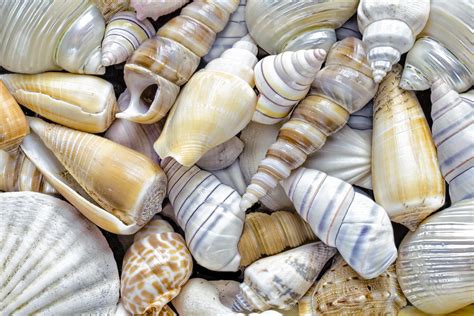The Ultimate Guide to Seashells: Unveiling the Beauty and Significance of Nature's Marine Treasures
Introduction
The ocean holds an enchanting allure, with its vast expanse concealing a world of wonders. Among these marvels, seashells stand out as exquisite creations, both delicate and resilient. They serve as a testament to the intricate workings of nature, offering insights into marine ecosystems and the extraordinary diversity of our planet. This comprehensive guide delves into the fascinating realm of seashells, unraveling their scientific significance, cultural importance, and practical applications.
A Scientific Odyssey: Unveiling the Secrets of Seashells
Composition and Formation:
Seashells are primarily composed of calcium carbonate, a substance they extract from seawater. Through a complex biological process, mollusks secrete this material onto an organic matrix, forming the intricate structures we see.
Shell Morphology:
The shape and appearance of seashells vary significantly, reflecting the diverse adaptations of mollusks to their environments. Some shells exhibit spiral or conical shapes, while others are flattened or irregular.


Microstructure:
Beneath the smooth exterior of seashells lies a world of microscopic complexity. The intricate arrangement of crystals and fibers determines their strength, color, and optical properties.
Cultural Significance: Seashells as Symbols and Artifacts
Throughout human history, seashells have played a profound role in cultures around the world.
Art and Decoration:
Seashells have been used for centuries in jewelry, artwork, and decorative items. Their intricate beauty and iridescent hues have inspired artists and artisans alike.

Religious Symbolism:
In many cultures, seashells have been associated with fertility, protection, and spiritual journeys. They are often found in religious artifacts and symbols.
Currency:
In certain societies, seashells have been used as a form of currency, particularly in coastal regions where they were abundant.
Practical Applications: Seashells Beyond Aesthetics
Jewelry and Fashion:
Seashells are widely used in jewelry making and fashion accessories. Their unique shapes and colors add a touch of natural elegance to any ensemble.

Building Materials:
In some parts of the world, seashells have been used as building materials, particularly in coastal areas where stone was scarce.
Medical Uses:
Seashells have been traditionally used in various medicinal practices. Some species contain compounds that have antibacterial and anti-inflammatory properties.

Common Mistakes to Avoid When Collecting and Preserving Seashells
Illegal Collection:
It is important to check local regulations before collecting seashells, as some species are protected by law.
Careless Handling:
Seashells can be fragile, so handle them with care to avoid damage. Use gloves to prevent transferring oils from your hands.
Chemical Preservation:
Avoid using harsh chemicals to preserve seashells, as these can damage their delicate structures. Natural methods such as drying or using a salt solution are preferred.
Frequently Asked Questions about Seashells
1. How old can seashells get?
Some species of seashells can live for hundreds of years, such as the giant clam.
2. What is the largest seashell?
The largest seashell in the world is the giant clam, which can grow up to 4 feet long and weigh over 500 pounds.

3. What is the most common seashell?
The periwinkle is the most common seashell in the world, with billions of individuals inhabiting various coastal ecosystems.
4. Are all seashells empty?
No, some seashells contain living mollusks. It is important to avoid collecting live specimens.
5. Can you eat seashells?
Some types of seashells, such as oysters and clams, are edible and widely consumed as seafood.
6. How can I identify different types of seashells?
There are many resources available to help identify different species of seashells, including field guides, online databases, and expert consultations.
Call to Action: Explore the Enchanting World of Seashells
The world of seashells is a vast and captivating one, inviting us to embark on a journey of discovery. Whether you are a budding naturalist, an avid collector, or simply someone who appreciates the beauty of nature, there is something for everyone in the realm of seashells.
Join the community of seashell enthusiasts and explore the wonders hidden within these marine treasures. Attend workshops, visit museums, and engage in citizen science projects to delve deeper into the fascinating world of seashells.
Remember, by embracing sustainable practices and respecting the delicate ecosystems they inhabit, we can ensure that these exceptional creations continue to grace our shores for generations to come.
